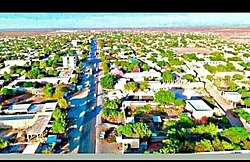Awash, Ethiopia
Awash Subah
Hawaash Subac Kiilo | |
|---|---|
[City Manucipality]] | |
| Awash Subah Kilo | |
 Awash City Administration is fast growing City in Afar Region | |
| Coordinates:8°59′N40°10′E/ 8.983°N 40.167°E | |
| Country | |
| Region | Afar Region |
| Zone | Administrative Zone 3 (Afar) |
| Government | |
| • Type | Town Administration |
| • Mayor | Ibrahim Ali (Assigned Currently) |
| Elevation | 986 m (3,235 ft) |
| Population (2005) | |
| • Total | 11,053 (est) |
| Climate | BSh |
Awash Subahis a market town in centralEthiopia.Located inAdministrative Zone 3of theAfar Region,above a gorge on theAwash River,after which the town is named,[1]the town lies on theAddis Ababa–Djibouti Railway,which crosses the gorge by a bridge there. It is the largest settlement inAwash Fentaleworeda.
Awash lies outside theAwash National Park,which is known for its wildlife, for theMount Fentalecalderaand for theFilwoha Hot Springs.Its market is held on Mondays, where Afar and Kereyu crafts can be found.[1][2]
History[edit]
An iron bridge over the Awash had been built at the present location of Awash by EmperorMenelik II'sfavorite,Alfred Ilg,around 1890; this bridge replaced an earlier wooden one. The construction had to face the great difficulty of transporting the girders fromDjibouti,but once the material had arrived, the structure had been finished in ten days; however Emperor Menelik had used for other purposes the cement imported from Europe to build the bridge with. When Count Gleichen encountered the bridge in 1897, during his mission to Emperor Menelik, he found "the bridge would be too weak to stand anything but ordinary pack-animal traffic. For nine months in the year it is blocked at each end by a broadabattisof thorn-bush, - to prevent people from using it when the river is fordable, - but during the rains it is left open. "[2]
Awash grew up around the railroad station, which was opened not long after 1917 when the railway had reached this far into Ethiopia. A hotel for passengers was built in Awash about that time.[3]The fourth post office in Ethiopia (afterHarar,Dire DawaandAddis Ababa) was established in Awash on 1 September 1923, but it may not have been much of a point of origin and arrival but rather a place on the line between the capital and the coast.[2]
During theItalian occupation,Awash still provided a post office, a telegraph station, the hotel, and restaurant. The town was occupied in April 1941 by the22nd East African Brigadeof theKing's African Rifles,who had advanced for three days from Dire Dawa. Elements of this brigade afterwards continued their advance across the Awash at this point on 3 April 1941, although the road and rail bridge had been demolished by the retreating Italians. By 1953, the bridge had been rebuilt.[2]
One of the five camps to train conscripts of the People's Militia (reconstituted in the spring of 1977 as the "Red Army" ) was located at Awash.
Rail disaster[edit]
On January 13, 1985, a train derailed at Awash on theEthio-Djibouti Railwaysplunging four of its five carriages into a ravine; the crash was estimated to have killed at least 428 and injured 500 of the estimated 1,000 on board. It was the worst rail accident in African history. It is believed that the cause of the crash was the excessive speed of the train round a curve on a bridge across the ravine. The derailment happened at 13:40 between Arba and Awash.[2]
Demographics[edit]
Based on figures from theCentral Statistical Agencyin 2005, Awash has an estimated total population of 11,053, of whom 5,748 are men and 5,305 were women.[4]According to the 1994 national census, the town had a population of 8,684.
Climate[edit]
| Climate data for Awash, elevation 1,052 m (3,451 ft), (1971–2000) | |||||||||||||
|---|---|---|---|---|---|---|---|---|---|---|---|---|---|
| Month | Jan | Feb | Mar | Apr | May | Jun | Jul | Aug | Sep | Oct | Nov | Dec | Year |
| Mean daily maximum °C (°F) | 30.8 (87.4) |
31.7 (89.1) |
33.5 (92.3) |
34.1 (93.4) |
36.0 (96.8) |
36.5 (97.7) |
33.4 (92.1) |
32.2 (90.0) |
33.5 (92.3) |
33.6 (92.5) |
31.8 (89.2) |
30.6 (87.1) |
33.1 (91.7) |
| Mean daily minimum °C (°F) | 14.8 (58.6) |
16.3 (61.3) |
18.1 (64.6) |
19.3 (66.7) |
20.3 (68.5) |
21.5 (70.7) |
19.6 (67.3) |
19.1 (66.4) |
19.9 (67.8) |
18.9 (66.0) |
15.3 (59.5) |
14.2 (57.6) |
18.1 (64.6) |
| Averageprecipitationmm (inches) | 21.0 (0.83) |
52.0 (2.05) |
59.0 (2.32) |
70.0 (2.76) |
57.0 (2.24) |
31.0 (1.22) |
118.0 (4.65) |
135.0 (5.31) |
63.0 (2.48) |
22.0 (0.87) |
15.0 (0.59) |
11.0 (0.43) |
654 (25.75) |
| Averagerelative humidity(%) | 50 | 48 | 51 | 52 | 42 | 44 | 56 | 61 | 51 | 41 | 42 | 43 | 48 |
| Source: FAO[5] | |||||||||||||
Notes[edit]
- ^Philip Briggs praises this gorge, noting "the drama of which is accentuated by a row of low volcanic hills above the opposite cliff. (Ethiopia: the Bradt Travel Guide,third edition [London: Bradt, 2002], p. 339)
- ^abcde"Local History in Ethiopia",The Nordic Africa Institute website.Archivedat theWayback Machineon February 28, 2008.
- ^Richard Pankhurst,Economic History of Ethiopia(Addis Ababa: Haile Selassie I University, 1968), p. 334.
- ^CSA 2005 National StatisticsArchivedNovember 23, 2006, at theWayback Machine,Table B.3, which calls the townAwash Sebat Kilo.
- ^"CLIMWAT climatic database".Food and Agriculture Organization of United Nations.Retrieved22 June2024.
External links[edit]
![]() Media related toAwash, Ethiopiaat Wikimedia Commons
Media related toAwash, Ethiopiaat Wikimedia Commons



